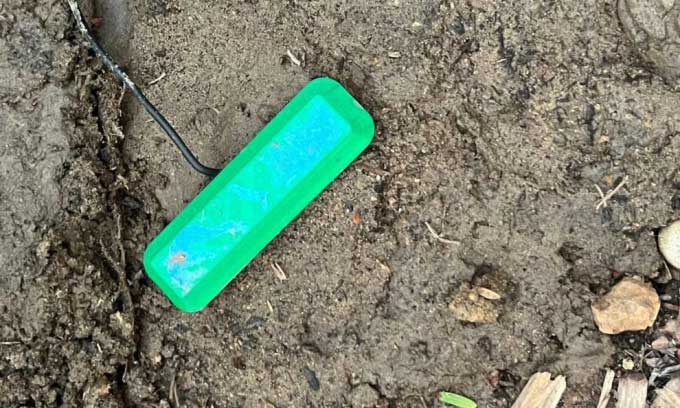A Northwestern University research team develops a new fuel cell that harnesses energy from soil-dwelling microorganisms.

3D printed cap of the fuel cell protruding from the ground. (Photo: Bill Yen/Northwestern University).
Soil-powered batteries are about the size of a small book, providing a viable alternative to batteries for underground sensors used in agriculture, reported Interesting Engineering on January 16. The new research was published in the journal Proceedings of the Association for Computing Machinery on Interactive, Mobile, Wearable, and Ubiquitous Technologies.
The research team emphasized the durability of the new fuel cell, noting its ability to withstand various environmental conditions, including arid soils and flood-prone areas.
“These microorganisms are abundant; they live in soil everywhere. We can use simple designed systems to harvest electricity from them. We won’t power an entire city with this amount of electricity. But we can harvest a small amount to serve practical applications that require little energy,” said George Wells, a member of the research team.
The chemicals from the battery can seep into the soil. Thus, the new technology also serves as an environmentally friendly alternative, alleviating concerns about toxic and flammable battery components.
The new fuel cell uses carbon fabric for the anode and inert, conductive metal for the cathode. The research team applied a waterproof material on the surface of the cathode, allowing it to function during flooding and ensuring it dries out after being submerged.

Clean fuel cell in the lab (left) and when covered in soil (right). (Photo: Bill Yen/Northwestern University)
The fuel cell prototype operates efficiently, generating electricity 68 times greater than what is needed to run its sensors. The battery is also robust enough to withstand significant fluctuations in soil moisture. The team also connected the soil sensors to a small antenna for wireless communication, enabling the fuel cell to transmit data to a nearby station. Notably, this new fuel cell operates effectively under both dry and wet conditions and performs about 120% longer than similar technologies.
“The number of devices in the Internet of Things is constantly increasing. Imagining a future with trillions of these devices, we cannot manufacture all of them using lithium, heavy metals, and hazardous substances that harm the environment,” stated Bill Yen, the lead researcher of the new study.
“We need to find alternative solutions that can provide small amounts of energy to operate a decentralized network of devices. To seek a solution, we studied soil microbial fuel cells, using special microorganisms to decompose soil and supply this small amount of electricity to sensors. As long as there is organic carbon in the soil for the microorganisms to decompose, the fuel cell can exist indefinitely,” Yen concluded.


















































